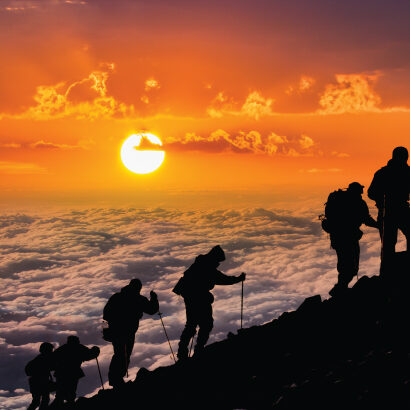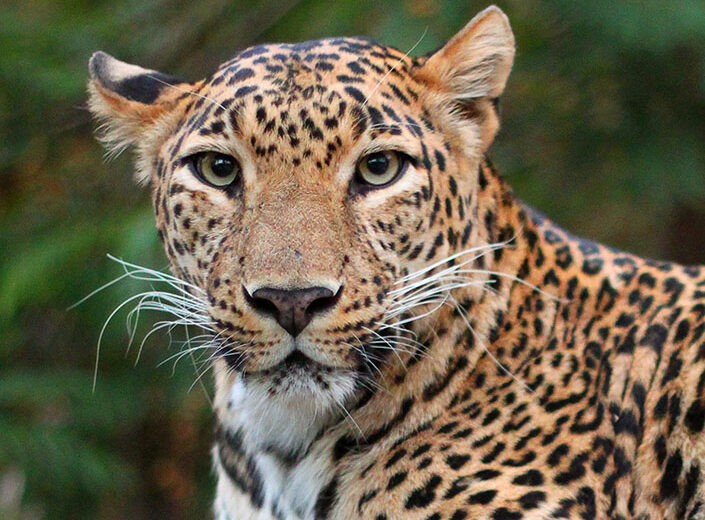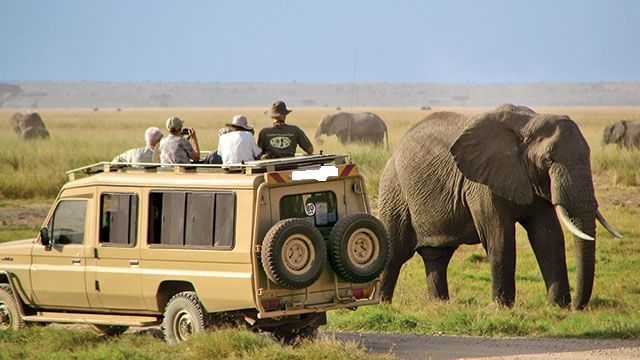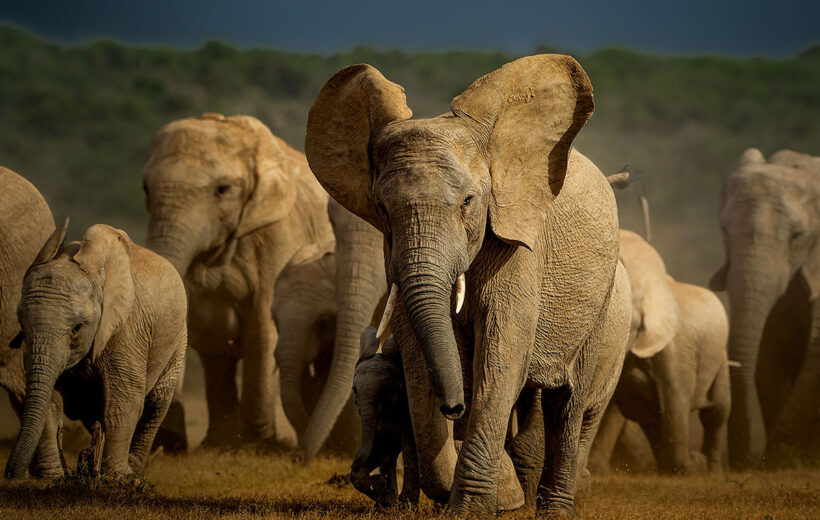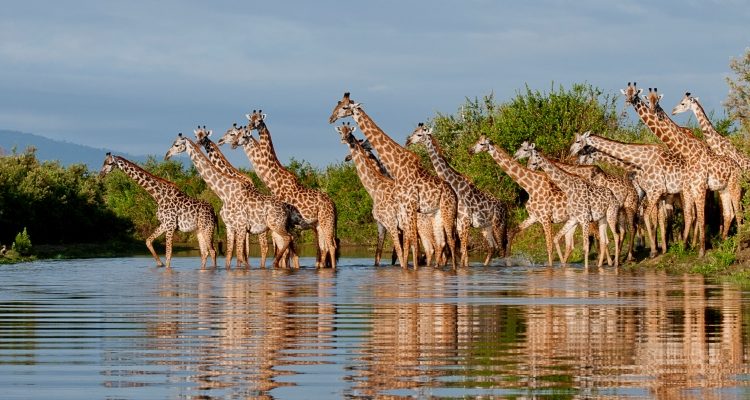Saadani National Park
Saadani National Park
Saadani National Park is a unique and relatively lesser-known conservation area located on the Indian Ocean coast of Tanzania. What sets Saadani apart is its extraordinary blend of diverse ecosystems, where savannah, wetlands, and coastal habitat meet the sea. Here's an overview of Saadani National Park:
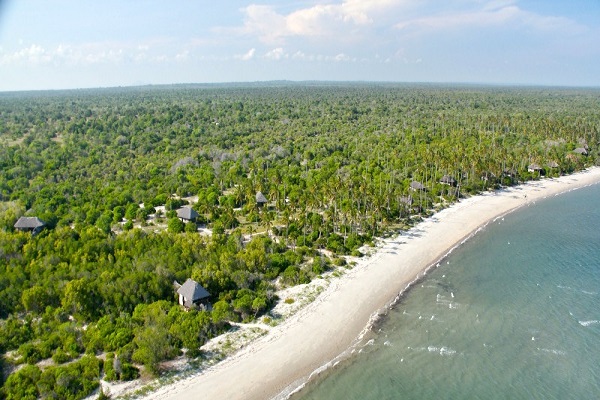
Key features of Saadani National Park
Coastal Location: Saadani National Park is the only national park in Tanzania that borders the Indian Ocean. Its proximity to the coast makes it a distinctive destination, combining the beauty of the ocean with traditional African wildlife.
2. Wildlife Diversity: The park is home to a variety of wildlife, including elephants, lions, leopards, buffalo, giraffes, zebras, and numerous antelope species. It's also a crucial habitat for the rare Roosevelt's sable antelope.
3. Primate Populations: Saadani is known for its primate populations, including yellow baboons, vervet monkeys, and red colobus monkeys. Watching these primates in a coastal setting is a unique experience.
4. Birdwatching: The park is a birdwatcher's paradise with over 350 bird species. You can spot a wide range of coastal and inland birds, including flamingos, fish eagles, and kingfishers.
5. Marine Life: Saadani's coastal location allows you to witness marine life such as dolphins, green and hawksbill turtles, and humpback whales during the migration season.
6. River Wami: The Wami River flows through the park and is home to a population of hippos and crocodiles. Boat safaris along the river provide opportunities to observe these creatures up close.
7. Boat Safaris: Explore the park's estuaries, rivers, and mangrove forests on boat safaris. These excursions offer a unique perspective on the park's wildlife and landscapes.
8. Cultural Experiences: The region surrounding Saadani National Park is inhabited by local communities, and visitors have the opportunity to interact with these communities and learn about their traditional way of life.
9. Bushwalks and Game Drives: Enjoy guided bushwalks and game drives, which allow you to explore the park's different ecosystems and discover the wide range of wildlife that call Saadani home.
10. Beach Access: The park boasts a pristine Indian Ocean coastline where you can relax on the beach, swim in the warm waters, and enjoy a coastal experience within a national park.
11. Accommodations: Saadani National Park offers a selection of accommodations, including lodges and tented camps that provide a comfortable and eco-friendly stay. These lodges often offer packages that include guided safaris and coastal experiences.
12. Accessibility: Saadani National Park is relatively accessible by road and air. You can fly to the park from Dar es Salaam or Zanzibar, or opt for a scenic drive from Dar es Salaam.
Best Time to Visit
- Overview
- Things To Do
- Dry Season
- Birdwatching
- Cultural Experiences
- Avoiding Crowds
- Accommodation
- How To Get There
The best time to visit Saadani National Park in Tanzania depends on your preferences and the type of experience you’re looking for, as the park offers a variety of attractions throughout the year. Here are some considerations for the best times to visit Saadani National Park:
1. Dry Season (June to October):
- The dry season is generally considered the best time to visit Saadani National Park for wildlife viewing. The weather is dry and cooler during this period, making it comfortable for outdoor activities.
- Wildlife congregates around water sources, offering excellent opportunities for game viewing as animals come to drink, including elephants, lions, and various antelope species.
- Birdwatching is also rewarding, as many migratory bird species visit the park during the dry season.
2. Late Dry Season (September and October):
- The end of the dry season, particularly September and October, is an excellent time for wildlife viewing. Vegetation is drier, making animals more visible, and there’s less water available in the bush, concentrating wildlife around rivers and lakes.
3. Wet Season (November to April):
- The wet season is the best time for birdwatching, as many migratory bird species visit the park during this time.
- The landscape becomes lush and green, creating beautiful scenery. It’s a good time for photographers looking for vibrant landscapes.
- However, wildlife can be more dispersed during the wet season because water is more abundant throughout the park. This can make game viewing a bit more challenging.
4. December to February (Calving Season):
- If you’re interested in witnessing calving and young wildlife, consider visiting during the short dry season from December to February. This is when many ungulates give birth, and you may see adorable baby animals.
5. Whale Watching (July to October):
- If you’re interested in whale watching, humpback whales can be seen off the coast from July to October during their migration. Boat safaris provide a chance to spot these majestic creatures.
6. Cultural Experiences (Year-Round):
- Cultural interactions with local communities can be enjoyed year-round. You can engage with nearby villages and learn about their traditions and way of life.
Keep in mind that weather patterns can vary from year to year, so it’s essential to check local conditions and the park’s accessibility before planning your trip. Regardless of the season, Saadani National Park offers a unique combination of wildlife, marine life, and coastal beauty that makes it a special destination for nature enthusiasts and adventure seekers.
Saadani National Park offers a range of activities and experiences that allow visitors to enjoy the park’s diverse ecosystems, wildlife, and coastal beauty. Here are some of the things you can do in Saadani National Park:
-
Game Drives: Embark on game drives to explore the park’s savannah and bush areas. Saadani is home to a variety of wildlife, including elephants, lions, giraffes, zebras, and antelope. Game drives provide opportunities to spot these animals and more.
-
Boat Safaris: Take a boat safari on the Wami River and its estuaries to observe hippos, crocodiles, and a wealth of birdlife. The boat ride offers a unique perspective of the park’s landscapes and wildlife from the water.
-
Walking Safaris: Join guided walking safaris to explore the park on foot. These walks provide a more intimate and up-close experience with nature, from tracking footprints to identifying bird species.
-
Birdwatching: Saadani is a birdwatcher’s paradise, with over 350 bird species. Bring your binoculars and bird field guide to spot flamingos, fish eagles, kingfishers, and many other avian species.
-
Marine Activities: Enjoy various marine activities such as swimming, snorkeling, and beachcombing along the Indian Ocean coastline. The park’s pristine beaches provide a relaxing and beautiful setting for seaside activities.
-
Dolphin Watching: Join boat excursions for dolphin watching. Saadani’s coastal waters are home to bottlenose and humpback dolphins, offering a chance to witness these playful and majestic creatures.
-
Turtle Watching: Visit the park’s beaches during the turtle nesting season (usually between June and October) to witness nesting and hatching events. Saadani is a vital site for green and hawksbill turtles.
-
Cultural Visits: Engage with local communities near the park to learn about their customs, traditions, and daily life. Some tour operators offer cultural visits and interactions with villagers.
-
Picnicking: Enjoy picnics within the park, surrounded by the natural beauty of Saadani. Picnic sites are available for visitors to relax and take in the scenery.
-
Camping: Camp within the park if you’re looking for an immersive experience in nature. Some accommodations offer camping options with facilities that provide a more comfortable camping experience.
-
Scenic Drives: Drive along the park’s coastal roads to take in the stunning views of the Indian Ocean and the scenic landscapes that make Saadani National Park a unique destination.
-
Bush Breakfasts and Sundowners: Some lodges and tour operators offer bush breakfasts and sundowner experiences, allowing you to enjoy meals and drinks in the heart of the wilderness or on the beach at sunset.
Saadani National Park’s diverse habitats, wildlife, and coastal setting make it a versatile destination that caters to a wide range of interests. Whether you’re a wildlife enthusiast, a nature lover, a beachgoer, or someone looking for cultural interactions, Saadani offers a blend of experiences that make it a memorable and unique safari destination in Tanzania.
The dry season in Saadani National Park typically occurs from June to October. This season is characterized by lower rainfall, making it an ideal time for various activities and wildlife viewing. Here’s what you can expect during the dry season in Saadani National Park:
1. Weather:
- The weather during the dry season is typically warm and sunny. Rainfall is minimal, leading to dry and often cloudless skies. Daytime temperatures are pleasant, and evenings can be cooler.
2. Wildlife Viewing:
- The dry season is the best time for wildlife viewing in Saadani National Park. As water sources within the park become scarcer, animals tend to congregate around the remaining waterholes and rivers, making it easier to spot them. You can expect to see a wide range of wildlife, including elephants, lions, giraffes, zebras, antelope, and various bird species.
3. Birdwatching:
- The dry season is excellent for birdwatching, as the park’s resident and migratory bird species are more visible. Bird enthusiasts can enjoy observing numerous avian species, including fish eagles, kingfishers, herons, and waders.
4. Game Drives:
- Game drives during the dry season offer an opportunity to explore the park’s savannah and bush areas without the hindrance of muddy roads. The drier conditions make the park’s road network more accessible.
5. River Safaris:
- River safaris on the Wami River and estuaries are more comfortable during the dry season, with lower water levels providing better visibility of hippos, crocodiles, and other aquatic life.
6. Walking Safaris:
- Guided walking safaris are popular during the dry season. You can venture on foot to explore the park’s landscapes, look for tracks and signs of wildlife, and enjoy the pleasant weather.
7. Whale Watching:
- Humpback whales migrate along the coast of Saadani National Park during their breeding season, typically from July to October. The dry season offers an excellent opportunity for whale watching.
8. Cultural Visits:
- Interactions with local communities can be more rewarding during the dry season, as communities may be more accessible and welcoming to visitors.
9. Beach Activities:
- Enjoy swimming, snorkeling, and relaxing on Saadani’s pristine beaches along the Indian Ocean. The dry season provides ideal beach weather and sea conditions.
While the dry season is a great time to visit Saadani National Park for wildlife enthusiasts and those seeking pleasant weather, it’s essential to plan your trip well in advance, as accommodations can fill up quickly during this popular time of the year. Overall, the dry season offers a combination of wildlife experiences, outdoor activities, and beach relaxation, making it an excellent choice for a safari adventure in Saadani.
-
Birdwatching in Saadani National Park is a rewarding and unique experience due to the park’s diverse ecosystems, which include coastal habitats, savannah, wetlands, and river estuaries. Here’s what you can expect when birdwatching in Saadani:
1. Bird Diversity: Saadani National Park is home to over 350 bird species, making it a fantastic destination for birdwatchers. The park’s varied environments attract a wide range of avian species, from waterbirds to raptors and forest-dwelling birds.
2. Coastal Birds: Saadani’s coastal location provides opportunities to spot a variety of coastal bird species. Look for shorebirds, gulls, terns, and waders along the park’s sandy shores and estuaries.
3. Riverine Birds: The park’s rivers and estuaries are a prime habitat for riverine birds. You can observe kingfishers, herons, egrets, and other species while on boat safaris along the Wami River.
4. Raptors: Keep an eye out for raptors soaring over the park’s open savannah and woodlands. You may spot fish eagles, African fish eagles, and martial eagles.
5. Waterbirds: Saadani is rich in wetland habitats, providing a home for various waterbirds. You can see African darters, storks, ibises, and spoonbills in the park’s wetland areas.
6. Mangrove Birds: Explore the park’s mangrove forests to find birds adapted to this unique coastal ecosystem. Look for species like mangrove kingfishers and mangrove herons.
7. Migratory Birds: Saadani National Park is a stopover for migratory birds, with many species arriving during the wet season. Birdwatchers can enjoy the sight of warblers, cuckoos, and other migratory visitors.
8. Bird Hides and Viewing Platforms: Some lodges and guided birdwatching tours offer bird hides and elevated viewing platforms, providing excellent vantage points for observing birds in their natural habitat.
9. Guided Birding Tours: To enhance your birdwatching experience, consider joining guided birding tours led by knowledgeable naturalists and bird experts. They can help you identify and spot both resident and migratory bird species.
10. Birding All Year Round: Birdwatching is rewarding year-round in Saadani. During the wet season, the presence of migratory birds adds diversity to the birding experience, while the dry season offers a chance to see more resident species.
11. Bird Photography: Saadani’s diverse birdlife and scenic landscapes make it an excellent location for bird photography. Make sure to have the right equipment to capture those memorable moments.
When birdwatching in Saadani National Park, be sure to bring a field guidebook, binoculars, and a bird checklist to help you identify the diverse species you’ll encounter. Whether you’re a dedicated birder or a casual observer, Saadani’s avian diversity and stunning coastal backdrop offer a memorable birdwatching experience in a unique African setting.
Cultural experiences in Saadani National Park offer visitors a chance to engage with the local communities and learn about the traditions and way of life of the people living in the surrounding areas. Here’s what you can expect from cultural interactions in and around Saadani National Park:
-
Local Villages: Many small villages are situated near the park’s boundaries. These villages are inhabited by ethnic groups such as the Zigua and Zaramo. You can visit these villages to observe traditional customs and lifestyles.
-
Cultural Workshops: Some lodges and tour operators offer cultural workshops, where you can participate in hands-on activities like pottery making, basket weaving, or cooking traditional dishes. These activities provide insight into the local artisanal skills and culinary traditions.
-
Traditional Dances and Music: On special occasions or by arrangement, local cultural groups may perform traditional dances and music. These performances showcase vibrant rhythms and movements that are an integral part of the local culture.
-
Traditional Healers: In some villages, you can meet with traditional healers who use herbal remedies for various ailments. They are willing to share their knowledge about medicinal plants and their cultural significance.
-
Local Markets: If your visit coincides with local markets, take the opportunity to explore them. You can witness the trading of goods and agricultural products, engage with local vendors, and purchase handcrafted items or locally grown produce.
-
Cultural Food Tastings: Savor traditional Tanzanian dishes and specialties prepared by local communities. This culinary experience allows you to sample the flavors of the region and gain an appreciation for the local cuisine.
-
Homestays: For a deeper and more immersive cultural experience, consider staying with local families. Homestays offer firsthand exposure to daily life, traditions, and the warmth of Tanzanian hospitality.
-
Respect and Sensitivity: When engaging in cultural experiences, it’s crucial to show respect and sensitivity to local customs and traditions. Seek permission before taking photographs and respect the privacy of community members.
Cultural interactions in and around Saadani National Park provide a more holistic perspective of the environment and its connection to conservation and wildlife protection. These experiences allow you to appreciate the cultural heritage of the area while supporting local communities through responsible tourism. It’s an opportunity to understand the human aspect of the park and its contribution to the broader ecosystem.
Saadani National Park is known for its remote and less crowded nature compared to many other national parks in Tanzania. Nevertheless, if you want to further minimize encounters with other visitors and have a more private experience, here are some strategies to consider:
-
Choose the Right Time to Visit: While Saadani is less crowded than some other parks, there are still peak and low seasons. The best times to visit with fewer visitors are during the wet season (November to April). However, be prepared for some rain during this period.
-
Weekday Visits: If possible, plan your visit for weekdays. Weekends can be slightly busier with local and domestic tourists.
-
Arrive Early: Start your day early by arriving at the park gates when it opens. This increases your chances of being one of the first visitors on the trails and encountering wildlife in a more tranquil setting.
-
Plan for Longer Stays: Consider an extended visit, spending more days in the park. This allows you to schedule your activities to avoid peak visitor times and have more exclusive wildlife encounters.
-
Private Tours: Opt for private or customized tours if your budget allows. These tours provide a more personalized experience and flexibility in setting your own itinerary.
-
Mid-Morning Departures: If you’re not an early riser, consider scheduling your activities to begin in the late morning when other visitors might be heading back from their morning excursions.
-
Respectful Behavior: Maintain respectful behavior during your visits, including keeping noise to a minimum and following the park’s rules and guidelines. This will also contribute to a quieter and more respectful atmosphere within the park.
-
Accommodations within the Park: Consider staying in accommodations within the park boundaries. Saadani Safari Lodge is one such option, offering a comfortable stay within the park and allowing you to plan your activities more flexibly.
-
Check Local Events: Be aware of local events, holidays, and school vacation periods that might attract larger crowds to the park and plan your visit accordingly.
While Saadani National Park doesn’t experience the same level of overcrowding as some other safari destinations, these strategies can help you make the most of your visit and enjoy a more peaceful and personal connection with the park’s unique natural and cultural attractions.
Accommodations in Saadani National Park offer a range of options that allow visitors to experience the park’s unique combination of wildlife, coastal beauty, and cultural interactions. Here are some of the accommodation choices you can find in Saadani National Park:
-
Saadani Safari Lodge:
- Saadani Safari Lodge is the primary and most well-known accommodation in the park. It provides a comfortable and eco-friendly stay while you explore the park.
- The lodge offers a range of options, including thatched roof bungalows and suites with en-suite facilities and private verandas.
- Accommodations are nestled in the forest and provide stunning views of the Indian Ocean or the Wami River, offering an immersive and secluded experience.
- The lodge features a restaurant serving a variety of dishes, often featuring fresh seafood from the Indian Ocean. You can enjoy your meals while taking in the stunning coastal views.
- Guided safaris and coastal experiences are easily accessible from the lodge, as it is located within the park’s boundaries.
- Saadani Safari Lodge often offers packages that include safari activities and cultural interactions.
-
Other Lodges and Tented Camps:
- While Saadani Safari Lodge is the primary accommodation within the park, you can also find a few other lodges and tented camps offering comfortable stays, some situated along the park’s coastline.
- These accommodations provide a mix of rustic charm and modern comforts, with various room options.
-
Accommodations in Nearby Villages:
- If you’re seeking a more immersive cultural experience, you can arrange to stay in guesthouses or lodges in nearby villages outside the park. This allows you to engage with local communities and experience their way of life more directly.
-
Camping: Some accommodations and tour operators provide camping options within the park. These options range from traditional camping to more luxurious glamping experiences.
When planning your stay in Saadani National Park, it’s essential to book accommodations well in advance, especially during the dry season when the park sees higher visitor numbers. Staying within or near the park’s boundaries allows you to enjoy the natural beauty and wildlife encounters with the convenience of easy access to the park’s activities and attractions. Regardless of your choice, accommodations in Saadani National Park are designed to enhance your experience of this unique and ecologically diverse destination on Tanzania’s coast.
Getting to Saadani National Park, located on the coast of Tanzania, typically involves a combination of land and air travel, as well as some road or boat transfers. Here’s how to get to Saadani National Park:
1. International Flight: Start by booking an international flight to Julius Nyerere International Airport (DAR) in Dar es Salaam, Tanzania. This is the main international gateway to the country.
2. Domestic Flight: From Dar es Salaam, you’ll need to book a domestic flight to Saadani Airstrip (located within the park) or Kigoma Airport (the nearest airport to Saadani).
-
If you fly into Saadani Airstrip: This is the most convenient option as it’s right within the park. However, flights to this airstrip may have limited schedules and availability, so it’s essential to check with the airline for the latest information.
-
If you fly into Kigoma Airport: Kigoma is the nearest major town to Saadani National Park, and it’s a common entry point. From Kigoma, you can arrange ground transportation to Saadani, which is approximately a 3-4 hour drive away.
3. Road Transfer: If you arrive in Kigoma, you can take a road transfer to Saadani National Park. Depending on your accommodation, this journey may include a combination of road and boat transfers. These transfers are often coordinated by the lodge or tour operator you choose to stay with.
4. Boat Transfer: Depending on your accommodation location within the park, you may need to take a boat transfer to access your lodge or camp. Some lodges in Saadani National Park are located along the coast, and boat transfers are a common means of reaching them.
5. Organized Tours: Many visitors opt to book organized tours or safari packages with reputable tour operators that include transportation to and within Saadani National Park. These tours often provide a hassle-free way to get to the park and explore its attractions.
It’s crucial to plan your travel to Saadani National Park well in advance, especially if you have specific accommodations in mind, as availability can vary. Keep in mind that road conditions and infrastructure in the region may vary, so be prepared for some off-road travel if you’re coming from Kigoma. Additionally, confirm your flight and transfer arrangements with your accommodations or tour operator to ensure a smooth journey to this unique coastal national park.

